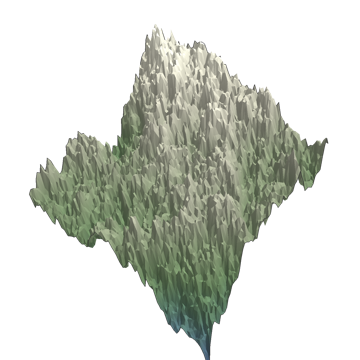Here's an extension on Sascha's method to a) CompiledFunctions and b) arbitrary MeshRegions:
planarTerrainFunction[steps : {{_, _}, ___},
init : Except[_List] : 0] :=
Block[{terrainX, terrainY},
With[{core =
Compile @@
Hold[
{{terrainX, _Real}, {terrainY, _Real}},
Evaluate@
Fold[
# + #2[[1]]*
Sign[#2[[2, 1]]*terrainX + #2[[2, 2]]*terrainY + #2[[2,
3]]] &,
init,
steps
],
RuntimeOptions -> {"EvaluateSymbolically" -> False}
]
},
With[{
multiDim =
Compile[{{clist, _Real, 2}},
Map[core[#[[1]], #[[2]]] &, clist],
RuntimeOptions -> {"EvaluateSymbolically" -> False}
]
},
Switch[Depth[#],
3, multiDim@#,
2, core@#,
_, $Failed
] &
]
]
];
planarTerrainFunction[
dist : _?DistributionParameterQ,
range : {_?NumericQ, _?NumericQ},
steps : _?IntegerQ,
init : Except[_List]
] :=
planarTerrainFunction[
Transpose@{
RandomVariate[dist, steps],
RandomReal[range, {steps, 3}]
},
init
];
planarTerrain[
fn_Function,
{coords_, cells_}
] :=
{
MapThread[
If[Length[#] == 3, {0, 0, #2} + #, Append[#, #2]] &, {#, fn@#} &@
coords], cells
};
planarTerrain[
{
dist : _?DistributionParameterQ : NormalDistribution[0, 0.02],
range : {_?NumericQ, _?NumericQ} : {-1, 1},
steps : _?IntegerQ : 100,
init : Except[_List] : 0
},
{coords_, cells_}
] :=
planarTerrain[
planarTerrainFunction[dist, range, steps, init],
{coords, cells}
];
planarTerrain[steps_Integer, {coords_, cells_}] :=
planarTerrain[
{
NormalDistribution[0, 0.02],
{-1, 1},
steps,
0
},
{coords, cells}
];
Options[planarTerrain] =
Options@DiscretizeRegion;
planarTerrain[
fn : _Function | _Integer | {
Optional[_?DistributionParameterQ,
NormalDistribution[0, 0.02]],
Optional[{_?NumericQ, _?NumericQ}, {-10, 10}],
Optional[_?IntegerQ, 100],
Optional[Except[_List], 0]
},
reg : _?RegionQ | Automatic : Automatic,
ops : OptionsPattern[]
] :=
With[{mr =
Replace[reg,
Automatic :>
DiscretizeRegion[Rectangle[], ops, MaxCellMeasure -> .001]
]},
MeshRegion @@
planarTerrain[fn,
{MeshCoordinates[mr], MeshCells[mr, All]}
]
];
Options[planarTerrainPlot] =
Join[
Options@SliceDensityPlot3D,
Options@planarTerrain
];
planarTerrainPlot[mr_?RegionQ, ops : OptionsPattern[]] :=
With[{rb = RegionBounds[mr]},
SliceDensityPlot3D[
z,
mr,
{x, rb[[1, 1]], rb[[1, 2]]},
{y, rb[[2, 1]], rb[[2, 2]]},
{z, rb[[3, 1]], rb[[3, 2]]},
Evaluate[
FilterRules[{
ops,
ColorFunction -> "AlpineColors",
Boxed -> False,
Axes -> False
},
Options@SliceDensityPlot3D
]
]
]
];
planarTerrainPlot[
tspec : {_Function | _Integer | {_, _, _, _}, _},
ops : OptionsPattern[]
] :=
planarTerrainPlot[
planarTerrain[Sequence @@ tspec,
FilterRules[{ops}, Options@planarTerrain]],
ops
];
planarTerrainPlot[t : _Function | _Integer | {_, _, _, _},
ops : OptionsPattern[]] :=
planarTerrainPlot[{t, Automatic}, ops]
Here's how it'd be used to build a standard mountainous terrain:
planarTerrainPlot[1000,
MaxCellMeasure -> .0001,
PerformanceGoal -> "Speed"
]

One nice thing about using MeshRegion is that we can easily plot over as Disk or any arbitrary discretizable region:
disk = DiscretizeRegion[Disk[], MaxCellMeasure -> .0001];
t = planarTerrain[2500, disk];
planarTerrainPlot[t]

Finally, since we're working with CompiledFunctions, the actual terrain generation is fast. The display tends to be the rate-limiting step. Here's a fun illustration of how well the time scales in the number of steps:
annulus = DiscretizeRegion[Annulus[], MaxCellMeasure -> .001];
frames =
Table[
With[{gen = AbsoluteTiming@planarTerrain[n, annulus]},
planarTerrainPlot[
gen[[2]],
PerformanceGoal -> "Speed",
ViewPoint -> {1, 0, 1.5},
PlotLabel ->
"`` Steps | Generated in `` seconds"~
TemplateApply~{n, gen[[1]]}
]
],
{n, Prepend[1]@Join[Range[50, 500, 50], Range[500, 1500, 250]]}
];

One last thing. We can use the various special regions to provide an initial shape for our final region to guide the terrain we want:
hill = ImplicitRegion[
0 <= x <= \[Pi] && 0 <= y <= \[Pi] && z == Sin[x] Sin[y], {x, y,
z}] //
DiscretizeRegion[#, MaxCellMeasure -> .0001] &

We'll make sure to restrict the sampling toward the center of the hill, too, so that things never get too out of control:
frames2 =
Table[
planarTerrainPlot[
planarTerrain[{NormalDistribution[0, Min@{.005*(1 + 1000/n), .2}],
n, 0}, hill],
PerformanceGoal -> "Speed",
ViewPoint -> {1, 1, 2}
],
{n, {10, 50, 100, 250, 500, 750, 1000}}
];
frames2 // ListAnimate
















